 Most viewed - MIE 三重県 Most viewed - MIE 三重県 |
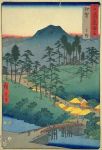
Hiroshige's woodblock print of Iga-Ueno from his "Famous Views of the 60 Provinces" series. The castle can be seen in the distance.118 views
|
|

Iga-Ueno Castle was first built by Takigawa Katsutoshi, a vassal of Kitabatake Nobuaki (Oda Nobuo, Nobunaga's second son). In 1585, Tsutsui Sadatsugu took over.117 views initiated construction of Iga Ueno Castle in 1585. He was followed by Tsutsui Sadatsugu
|
|

In 1611, Todo Takatora took over Ueno Castle. Iga-Ueno Castle is also a major cherry blossom spot in early April.117 views
|
|

In 1980, Ueno Castle served as a backdrop for Kurosawa Akira's movie, Kagemusha.117 views
|
|

Top floor117 views
|
|

Bust of Kawasaki Katsu.117 views
|
|

Inside the Chogetsuken study. 釣月軒117 views
|
|
|

This is definitely one of the more unique and exciting festivals I have seen in Japan. I have to give much credit to these young and brave lads.117 views
|
|

117 views
|
|

117 views
|
|

117 views
|
|

The other end of the riding course. 117 views
|
|

This event is called yabusame. Although they wear arrows on their backs, they do not shoot any arrows while riding. They just gallop straight along the course.117 views
|
|

This rider I will never forget.117 views
|
|

116 views
|
|
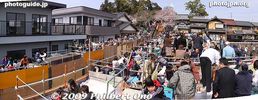
The bleacher seats are sold by auction to the highest bidder. Those next to the steep incline are the most expensive, costing 200,000 yen or higher for one compartment fitting several people. I was in a compartment costing 7,000 yen.116 views
|
|

The next rider is prepared. He sits in a sacred compartment, gets his hanagasa hat adjusted, and waits for his horse to arrive. He was stern-faced. There's a 15-20 min. break between each Ageuma run.116 views
|
|

This horse was the most successful of the day. It made a clean leap in one try.116 views
|
|

The horse makes a nice leap up.116 views
|
|

Inabe Shrine's statue of a sacred horse near the horse riding ground.116 views
|
|
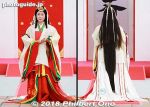
In the end, the Saio princess slowly walked through the palace door that opened for her. Her long, black hair and way of walking were very elegant. After she entered, the doors closed and the festival was over.116 views
|
|
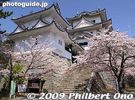
115 views
|
|

115 views
|
|

View from atop Iga-Ueno Castle.115 views
|
|

One of the tallest castle walls in Japan.115 views
|
|

115 views
|
|
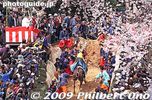
And there he goes up on the incline.115 views
|
|

One of the jockeys shoots an arrow toward the river.115 views
|
|

The jockeys galloped through the course several times.115 views
|
|

Saio princess in a palanquin in Meiwa, Mie Prefecture. The Saio princess was selected from tens of candidates. This was her fourth time to apply for the honor and she was finally selected.115 viewsIt is to promote the town so she was very willing to pose for pictures. The makeup person did a very good job.
|
|

Haisei-den and wisteria in bloom. The Basho Matsuri Festival is a poetry reading held here on Oct. 12.114 views
|
|

114 views
|
|

The procession crosses the river and heads for the horse riding ground. 神霊渡御114 views
|
|

One rider waves around his baton before tossing it. This lucky little girl got one.114 views
|
|

It must be fun to ride that fast.114 views
|
|

113 views
|
|

113 views
|
|

113 views
|
|

They kept riding back and forth until twilight. Toward the end, they tossed these batons to people.113 views
|
|

And so all these people are waving their arms shouting, "Toss it to me!" Also see my YouTube video here.113 views
|
|

Ise-shi Station with kadomatsu New Year's decorations.113 views
|
|
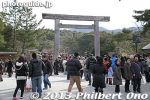
Torii gate at Uji Bridge. Very crowded with New Year's worshippers going for hatsumode prayers.113 views
|
|

They are still excavating a few areas of the castle for historical remains. I visited in April 2009.112 views
|
|

Stone marker for Ueno Castle located in Ueno Park. Officially called Ueno Castle and nicknamed Hakuho Castle or Iga-Ueno Castle. Noted for cherry blossoms in April and the highest castle walls in Japan.112 views
|
|

There he goes.112 views
|
|

Rider and his hat.112 views
|
|

112 views
|
|

112 views
|
|

112 views
|
|

112 views
|
|

Ise Jingu Shrine's Naiku is officially named, "Kotaijingu" (皇大神宮). It worships Amaterasu Omikami 天照坐皇大御神, the ancestor of the Imperial Family and the tutelary kami of the Japanese people. Naiku was founded 2000 years a112 views
|
|
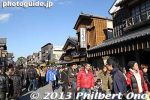
Oharai-machi shopping street outside Naiku entrance. Bus stop for the train stations and Geku is near here.112 views
|
|

Castle wall111 viewsThe stone wall is long, and the entrance to the castle grounds is on the far end, in front of the three-story Ushitora turret.
|
|

Inside the Haisei-den is a ceramic statue of Basho.111 views
|
|

Rider with hat bearing an iris flower prepares to mount.111 views
|
|

Foundation of the castle tower110 viewsThe 5-story castle tower was destroyed in 1600 during the Battle of Sekigahara. It was never rebuilt.
|
|

110 views
|
|

110 views
|
|

Urinal110 views
|
|

Kitchen stoves110 views
|
|

The group of men sing for the rider.110 views
|
|

Here he comes, ready to toss his baton. Now I was watching this through my camera lens and shooting continuously at 6 frames per sec.110 views
|
|

The only castle wall remaining at Toba Castle.110 views
|
|

A well remaining at Toba Castle.110 views
|
|

109 views
|
|

View from atop Iga-Ueno Castle, looking toward Ueno-shi Station.109 views
|
|

Toba Castle109 views
|
|

Iga-Ueno Castle and cherry blossoms, Mie Prefecture.108 views
|
|

108 views
|
|

Iga-Ueno Castle's donjon or tenshu tower was reconstructed in 1935 by Kawasaki Katsu, a local politician, using his own funds.108 views
|
|

Todo Takatora was originally from Omi or neighboring Shiga Prefecture.108 views
|
|

108 views
|
|

The Haisei-den was designed to look like Basho in travel clothing. The top roof resembles a hat, and the lower roof resembles his straw raincoat. Cherry blossoms were in bloom.108 views
|
|

108 views
|
|

Small door to the kitchen. People must have been pretty short then.108 views
|
|
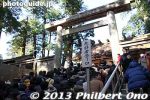
We didn't get to go through the torii, but it wasn't worth the wait. They never explained the difference between staying in the middle of the steps and going up on the right edge.108 views
|
|
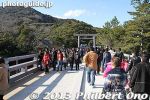
Crossing Uji Bridge on the way back.108 views
|
|
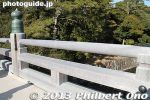
Uji Bridge showing its 20-year age.108 views
|
|

You could jump off into the moat below. No fences, so watch your kids.107 views
|
|

Saio princess in a palanquin in Meiwa, Mie Prefecture.107 views
|
|

Inner stone wall106 views
|
|

Foundation of the castle tower (side view)106 views
|
|

106 views
|
|

Edge of castle wall.106 views
|
|

Park area above the castle wall.106 views
|
|

106 views
|
|

The building was designed by architect Ito Chota (1867-1954) (伊東 忠太) who designed numerous shrine and temple buildings in the 1920s and '30s, including Tsukiji Hongwanji temple in Tokyo.106 views
|
|

Water well106 views
|
|
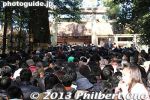
On the steps going up to Naiku shrine. This was where it got ridiculous. Literally a snail's pace.106 views
|
|
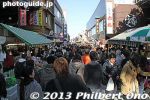
Right outside the entrance Naiku is a long shopping street called Oharai-machi, mainly food stalls. it leads to a parking lot. Very crowded on New Year's Day.106 views
|
|

105 views
|
|

105 views
|
|

105 views
|
|

Toilets and bath105 views
|
|
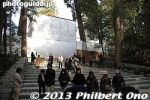
This is the steps leading to the new Naiku shrine that will be completed this fall 2013. The shrine buildings are already close to completion, but they are covered up.105 views
|
|
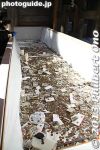
Small offertory box.105 views
|
|
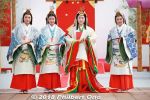
Posing with court ladies called the Uneme (釆女) chosen from an aristocratic family and who was in charge of food and drink.105 views
|
|

104 views
|
|

104 views
|
|

104 views
|
|

104 views
|
|

Saio princess in a palanquin in Meiwa, Mie Prefecture.104 views
|
|
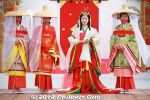
Posing with leading court ladies called the Myobu (命婦), assistants who tend to the immediate needs of the Saio princess.104 views
|
|

103 views
|
|

The other end of Uji Bridge also has a torii gate.103 views
|
|
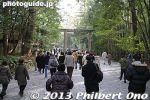
We could easily proceed from Uji Bridge to this Daini (Second) torii. So far so good.103 views
|
|
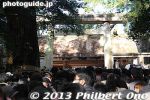
Naiku torii at the top of the steps.103 views
|
|

103 views
|
|

This is the Saio princess sitting in a palanquin on wheels. In Saiku, the Saio's palanquin is called Sokaren (葱華輦), meaning "Onion Flower Palanquin" in reference to its onion-shaped giboshi roof ornament.103 viewsThe Saio palanquin bearers are called Kayocho (駕輿丁) who were chosen from the best gentlemen.
|
|
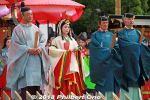
The man on the far right in dark blue is Ise Kokushi (伊勢国司) Governor of Ise Province. Next to him also in blue is the Chobusoshi (長奉送使) director of the Saio procession.103 views
|
|

The people who went up the right edge of the steps didn't go through the torii and could only pray at a temporary, off-center position under the slim roof seen here on the right of the thatched-roof gate. 102 views
|
|

Dried fish.102 views
|
|

101 views
|
|

Crossing Uji Bridge, a little over 100 meters long. 宇治橋101 views
|
|
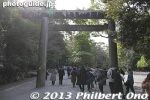
The first torii or Daiichi torii.101 views
|
|
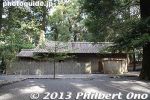
Horse stable.101 views
|
|
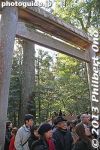
Naiku's bottleneck. These people took at least an hour to climb up the steps to go through this little torii. So it must've taken them at least 2 hours to get here from Uji Bridge. Normally it's a 10-15 min. walk.101 views
|
|

My video of Ise Jingu Naiku on Jan. 1, 2013.101 views
|
|
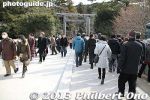
100 views
|
|
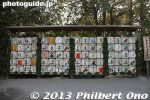
Barrels of sake as offerings.100 views
|
|
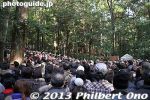
Getting closer to the bottom of the steps leading up to the Naiku shrine.100 views
|
|

Saio princess in a palanquin in Meiwa, Mie Prefecture. Very photogenic makeup and costume.100 views
|
|

Stone wall in the Honmaru99 views
|
|
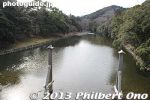
Uji Bridge goes over Isuzu River. 五十鈴川99 views
|
|

Place to dispose of old decorations bought from the shrine.99 views
|
|
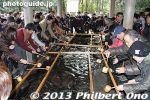
Before praying at the shrine, you're supposed to purify yourself. Wash your hands and rinse your mouth here. Use the ladle to pour water into your hand, then sip the water from your hand. Don't sip the water directly from the ladle. 手水舎99 views
|
|
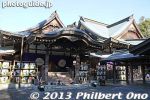
Kaguraden hall for sacred dances and prayers. 内宮神楽殿99 views
|
|

The museum has this colorful Seki-juku manhole, Kameyama, Mie Prefecture. They even give you a manhole card.99 views
|
|
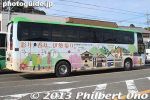
Colorful bus at Ise.98 views
|
|

Dip your hands here in Isuzu River. Auto maker Isuzu was named after this crystal-clear river. 五十鈴川と御手洗場98 views
|
|
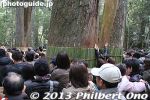
Bamboo strips protect the trees.98 views
|
|
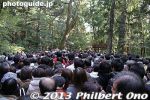
I could see the heatwaves from the people's bodies. Still inching forward.98 views
|
|

Ranryo-o court dance dating to the Nara Period (8th century). Chinese warrior Ranryo-o was Prince of Lanling (Gao Changgong), a victorious 6th c. general. (舞樂蘭陵王).98 viewsTo hide his gentle-looking face, Ranryo-o wore a fierce mask in battle. Notice the dragon head mask.
|
|
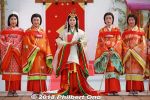
Posing with court ladies called Nyoju (女嬬) who serve in the inner palace (後宮) and take care of the Saio princess' daily living.98 views
|
|

97 views
|
|
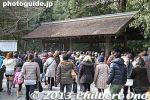
Water fountain where you wash your hands and rinse your mouth for purification. 手水舎97 views
|
|
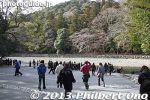
Another place to purify yourself on the banks of Isuzu River at this place called the Mitarashi. 五十鈴川と御手洗場97 views
|
|
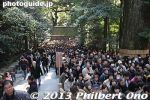
The scene from the top of the steps. People on the right are aiming for the torii. People on the left are shooting up the steps in no time.97 views
|
|
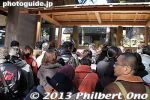
There was a money box under both the thatched roof and under the slim roof structure next to it. Either way, you can still pray at the shrine. Not a big deal if you don't go through the torii or don't pray from the center spot under the thatched97 viewsIt really looked like the people going up on the right edge were exiting without praying at the shrine. Not so. They could also pray at the shrine, but at an off-center position.
|
|
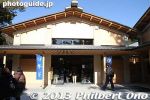
Sanshuden rest house97 views
|
|

Lucky bags.97 views
|
|

Everyone here are volunteers, includng the festival staff behind the scenes. The festival is directed by a group (named Komachi 小町) of former Saio princesses and other characters who train the current year's festival participants.97 views
|
|

96 views
|
|
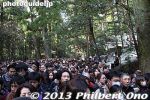
Lot of people here, but it's still not as crowded as Meiji Shrine in Tokyo.96 views
|
|
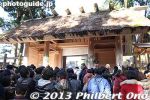
After going through the torii, they could pray at this center position under this thatched-roof gate in front of the shrine.96 views
|
|
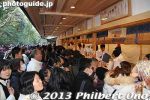
The great thing for them is that they need not provide any guarantee that your hopes, dreams, and prayers will come true for you. No such thing as a product warranty nor money-back guarantee.96 views
|
|
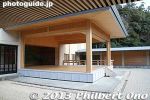
THe rest house had a view of a Noh stage.96 views
|
|

Taka-no-miya Shrine 多賀宮95 views
|
|

Bus stop for Naiku Inner Shrine. This is near Ise-shi Station.95 views
|
|

A guard watching over the crowd crossing Uji Bridge.95 views
|
|
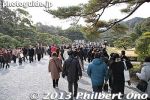
After crossing Uji Bridge, it is a gravel path to the shrine.95 views
|
|
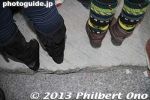
At the bottom of the steps going up to the shrine.95 views
|
|
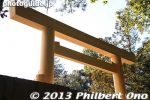
Brand new wooden torii.95 views
|
|
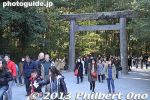
People still streaming toward Naiku shrine passing through the second torii.95 views
|
|
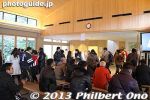
Inside Sanshuden rest house, a nice warm place to rest.95 views
|
|

Isuzu River as seen from Uji Bridge. Water from this river is used in the shrine's ceremonies and rituals.95 views
|
|

Next to the Waki-Honjin was the Honjin whose site is now occupied by this building.94 views
|
|

94 views
|
|
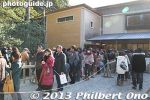
Much more popular than sake was amazake (sweet sake). This line was too long for me so I skipped it.94 views
|
|

Kameyama Castle manhole in Kameyama, Mie Prefecture.94 views
|
|

Inside the bus going to Naiku from Ise-shi Station.93 views
|
|
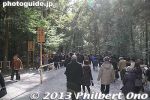
Still walking at a good pace.93 views
|
|
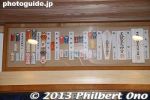
Imagine providing a service or product for which you need not worry about complaints, defects, malfunctions, errors, or failures. And the customer base is guaranteed forever. 93 views
|
|
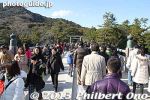
Uji Bridge on the way back.93 views
|
|

Irises in early June in Meiwa, Mie Prefecture. Meiwa's official flower. Ancient texts mention that pilgrims going to worship at Ise Shrines described it like walking on clouds of purple.93 views
|
|
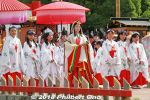
After the arrival ceremony, they held a picture-taking session with the Saio princess who posed with each group of characters. 93 viewsAnyone could take pictures. This was a great PR strategy. Obviously, social media fodder. Got some good photos of everyone.
|
|

Seki-juku is highly recommended for Tokaido stage town and architecture fans. Seki-juku manhole with a traveler design, Kameyama, Mie Prefecture.93 views
|
|

Noted for cherry blossoms, Kyuka Park is on the site of Kuwana Castle which was occupied by Honda Tadakatsu. 92 views
|
|
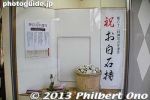
White rocks to be placed at Ise Jingu Shrine for the rebulding.92 views
|
|

Bus with motif promoting Ise. Going to worship at Ise Jingu is called "Ise-mairi."92 views
|
|
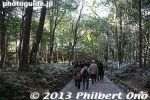
92 views
|
|

The Departure Ceremony at Saiku Heian-no-mori Park gathered all the people in traditional costume. 出発式92 viewsSaiku Heian-no-mori Park (Saiku Heian Era Park) recreates one of the many rectangular blocks of the Saiku Palace area. This one reconstructs three buildings used by the head of the Saikuryo, the government office of the Saiku Palace. This main building is the Seiden (正殿) dating from the 9th century used to conduct important ceremonies by the head of the Saikuryo and to welcome official messengers from Ise Grand Shrines and Kyoto. Saio Matsuri is a tourist/community festival, not a religious festival held by any shrine. Run by a volunteer committee.
|
|

Statue of Lord Honda Tadakatsu at Kyuka Park, site of his Kuwana Castle.91 views
|
|

Site of Kuwana-juku's Honjin.91 views
|
|
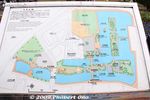
Map of Kyuka Park on the site of Kuwana Castle.91 views
|
|

Sando path from Ise-shi Station to Ise Jingu Shrine's Geku Outer Shrine. A short walk. You're supposed to visit Geku before Naiku.91 views
|
|
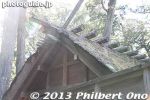
91 views
|
|
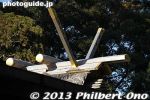
This is all we can see of the main shrine building called the Shoden (正殿), the home of Amaterasu. The design of the shrine buildings are especially beautiful and awe-inspiring. Too bad we can't see it. There are photographs (especially by Yoshio 91 views
|
|
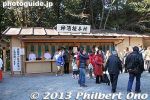
A sip of sake at this booth. I saw no indications of a fee for this sake, but there was a donation tray right there.91 views
|
|
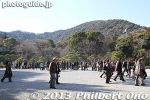
Where the people coming and going converge at Ise Jingu's Naiku.91 views
|
|

Building on the site of Kuwana-juku's Waki-Honjin. It is a ryokan inn.90 views
|
|
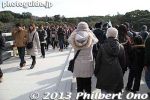
Uji Bridge is also rebuilt every 20 years.90 views
|
|
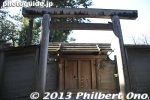
Side torii gate at Naiku.90 views
|
|
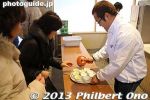
They served free green tea.90 views
|
|

These blossoms were 1 or 2 days before reaching full bloom in early April.89 views
|
|

Geku is Ise Jingu's Outer Shrine (officially named "Toyouke Daijingu"). It is one of the two main shrines of Ise Jingu. Geku worships the god Toyouke Omikami, who is responsible for the food of Amaterasu Omikami worshipped at Naiku.89 views
|
|
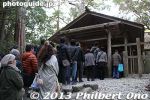
Taka-no-miya Shrine 多賀宮89 views
|
|
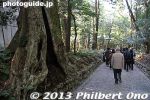
Way back.89 views
|
|

Kyuka Park cherry blossoms in Kuwana, Mie.88 views
|
|
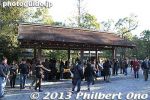
Water fountain where you wash your hands and rinse your mouth for purification. 手水舎88 views
|
|
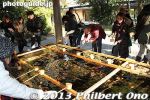
Before praying at the shrine, you're supposed to purify yourself. Wash your hands and rinse your mouth here. Use the ladle to pour water into your hand, then sip the water from your hand. Don't sip the water directly from the ladle. 手水舎88 views
|
|
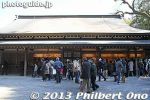
Shrine gift shop for amulets etc. Make no doubt, religion in Japan is very big business. They are in the business of selling hopes, dreams, prayers, ceremonies, and amulets. 88 views
|
|

Sign explaining Kuwana's Honjin and Waki-Honjin.87 views
|
|
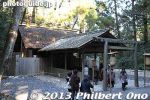
Kaze-no-miya Shrine is dedicated to the gods of wind and rain, essential for farming. 風宮87 views
|
|

Way to Honmaru, the central part of the castle.86 views
|
|

86 views
|
|

86 views
|
|
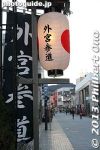
I noticed that Geku was much less crowded than Naiku and apparently most people visit Naiku only. Lantern along the path to Geku.86 views
|
|
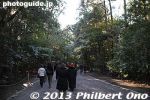
Sando path to Geku.86 views
|
|
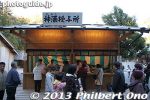
A sip of sake at this booth.86 views
|
|
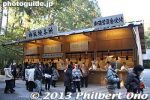
Amulets forsale.86 views
|
|

Tsuchi-no-miya Shrine 土宮86 views
|
|
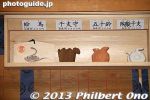
Snake souvenirs for sale. Major Shinto shrines make much of their income during New Year's.86 views
|
|

The best part of Kyuka Park is in the Ninomaru area.85 views
|
|

Site of Tatsumi turret.85 views
|
|

Ise Tourist Information across from the Geku entrance. Very helpful.85 views
|
|
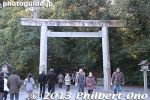
The first or Daiichi torii gate.85 views
|
|
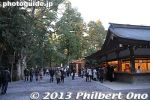
85 views
|
|
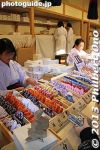
The great thing for them is that they need not provide any guarantee that your hopes, dreams, and prayers will come true for you. No such thing as a product warranty nor money-back guarantee.85 views
|
|
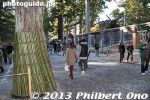
85 views
|
|

85 views
|
|

85 views
|
|
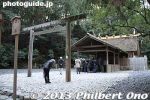
Tsuchi-no-miya Shrine worships the god in charge of the land around Geku. 土宮85 views
|
|
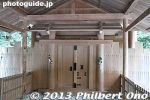
Tsuchi-no-miya Shrine 土宮85 views
|
|
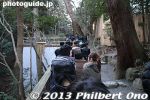
Long line to pray at Taka-no-miya Shrine. "Taka" literally means "many felicitations." 多賀宮85 views
|
|
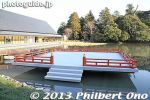
Outdoor stage at Sengu-kan.85 views
|
|
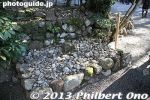
85 views
|
|
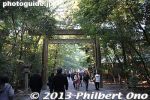
84 views
|
|
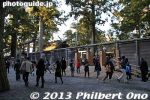
Geku Outer Shrine84 views
|
|
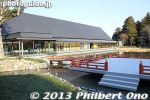
Sengu-kan Museum includes a scale model of the Geku shrine as well as a life-size facade of the main shrine building. Don't miss this museum. 84 views
|
|

Honmaru of Kuwana Castle. No castle buildings remain. Only moats and turret foundations. A shrine occupies much of the Honmaru area.83 views
|
|

83 views
|
|

Ibigawa River83 views
|
|
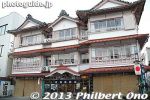
Old ryokan inn.83 views
|
|
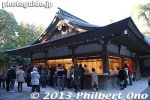
Shrine gift shop for amulets etc. Make no doubt, religion in Japan is very big business. They are in the business of selling hopes, dreams, prayers, ceremonies, and amulets. 83 views
|
|
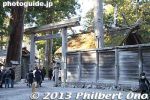
83 views
|
|
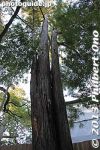
83 views
|
|

82 views
|
|

82 views
|
|
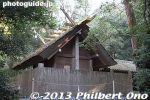
After praying at Geku, most people also visit three nearby affiliate shrines: Kaze-no-miya, Tsuchi-no-miya, and Taka-no-miya. This is Kaze-no-miya Shrine. 風宮82 views
|
|

Taka-no-miya Shrine 多賀宮82 views
|
|

Many red bridges at Kyuka Park.81 views
|
|
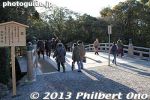
Path to Geku. 第一鳥居口参道81 views
|
|
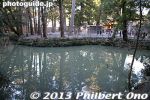
Adjacent pond.81 views
|
|

Taka-no-miya Shrine, old and new. 多賀宮.81 views
|
|

80 views
|
|

Shichiri-no-watashi at Kuwana, Mie. Adjacent to Kyuka Park is the Kuwana-juku post town on the Tokaido Road. The building on the right is on the site of the Waki-Honjin.80 views
|
|
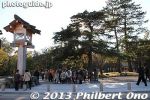
Geku entrance. Toyouke Omikami is also the god for food, clothing, and shelter. Geku was founded about 1,500 years ago.80 views
|
|
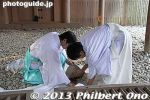
Collecting coins at Taka-no-miya Shrine 多賀宮.80 views
|
|
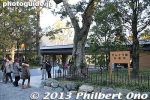
A new museum called Sengu-kan to commemorate the shrine's rebuilding for the 62nd time (since over 1,200 years ago).80 views
|
|
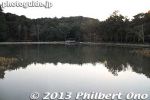
Magatama Pond next to Sengu-kan.80 views
|
|

79 views
|
|
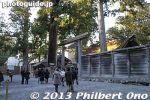
79 views
|
|
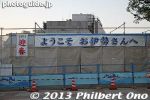
They are renovating the space in front of Ise-shi Station.79 views
|
|

78 views
|
|

78 views
|
|

The controversial Nagaragawa Dam. The Nagaragawa River and Ibi River run parallel to each other in this area until they merge as the Ibi River.78 views
|
|
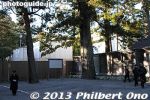
The new Geku Outer Shrine to be unveiled in Oct. 2013.78 views
|
|

The shrine is rebuilt every 20 years and 2013 will mark the completion of the new shrine to replace the old one built in 1993. It takes 8 years to rebuild the Naiku shrine. So 12 years from now, they will start the rebuilding process all over again.77 views
|
|

Ise-shi Station. 伊勢市駅77 views
|
|

76 views
|
|
| 1114 files on 5 page(s) |
2 |  |
 |
|